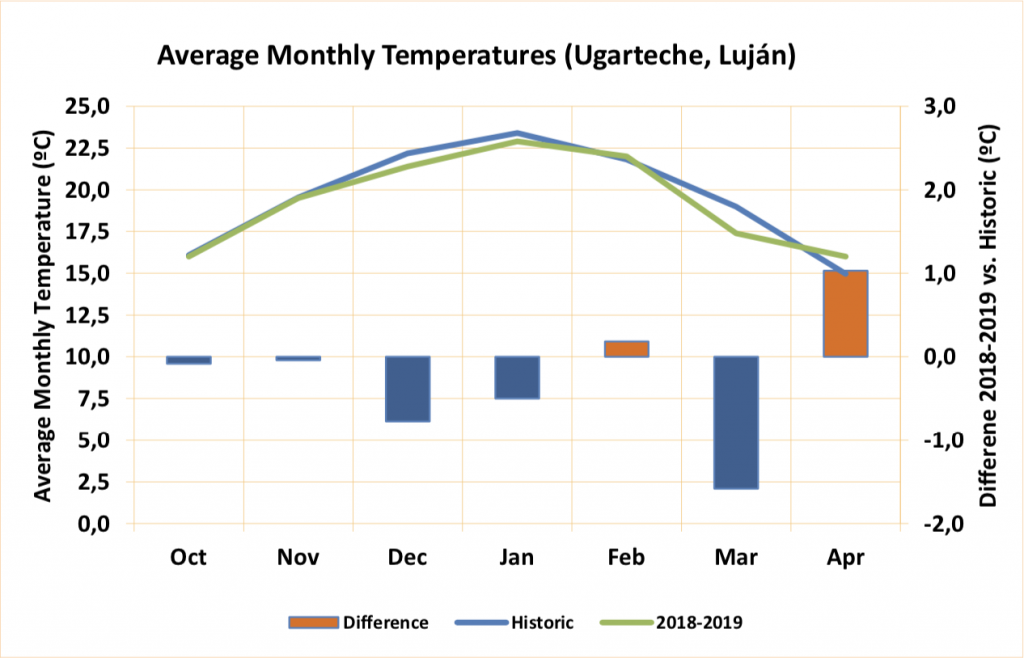We can classify the 2019 harvest as an exceptional vintage for the quality of its wines. Curiously, it is climatically similar to the previous harvest, also remembered for its excellent results. In summary, it was slightly cooler than the historical average, with a normal volume of rainfall, despite the fact in December and January there were many days of high temperatures. It will be remembered as one of the best vintages of the decade since the favorable climatic conditions allowed the picking schedule with the desired maturity. Due to the shortage of rains in February and most of March, the health of the grapes was exceptional and the wines obtained both white and red, showed excellent quality.
Phenology
Bud break of the 2018-2019 season occurred in regular dates. Malbec of Luján de Cuyo budded between September 27th and 30th, while in the Uco Valley the bud break took place between October 3rd and 15th for Gualtallary and El Cepillo in San Carlos respectively for the same variety. Flowering occurred on normal dates, for example, in mid-November for Malbec of Luján de Cuyo, in a year with normal spring temperatures. On the other hand, veraison also happened in regular dates, in mid-January. Finally, the harvest of white and red grapes was in usual dates compared with past seasons. Autumn was very long and unlike 2018, there was no incidence of frost towards the end of the harvest so it developed quietly until its end. Regionally and nationally, the total harvested volume was similar to that of last season, with a 1.8% and 7% lower respectively than the previous harvest.
Temperatures
Spring of 2018 presented normal temperatures for the season (see graph 1) and there was no record of strong Zonda winds, which allowed for a good fruit set of inflorescences. Frosts did not have and important impact either.
Summer also came with normal temperatures for January and February, slightly cooler during March, while in April they were higher than usual. Although temperatures were close to historical averages in general, several days were recorded with temperatures higher than 32 °C (38 days compared with 29.5 days as the average).

Graph 1: average monthly temperatures during the 2018-2019 season
Rainfall
During spring, accumulated rainfall was normal for the season (104 millimeters). The same can be said for summer rainfall, when grapes ripen (January to April) with 174 millimeters. February and the first fortnight of March, a key period for the ripening of white grapes, were particularly dry allowing for a complete health of the grapes. The rains registered at the end of March, relatively abundant, did not compromise the health of the grapes, which was also possible thanks to a very dry April.

Graph 2: average monthly rainfall during 2018-2019 season.
Wines
Luján de Cuyo
Whites: Excellent health and aromatic purity with good yields. At first, ripening was delayed in 12 days, but after a few very warm days in February, aromas evolved to the more tropical aromas while maintaining an elevated natural acidity.
Reds: This area presented lower yields compared to the 2018 harvest and to the historical average, especially in Malbec. However, other varieties such as Petit Verdot and Bonarda yielded similarly to the historical average. We can observe highly intense aromatic wines, blending floral aromas with red fruits and spices. On the palate, tannins are firmer than other vintages, anticipating an excellent ageability.
Uco Valley
Whites: They also presented excellent health and great varietal purity from the aromatic point of view. The Riesling sources from high altitude vineyards shows great width in the palate and a good fat level enabling long-finish wines. Sauvignon Blanc and Chardonnay show more mature aromas compared with previous seasons, being affected by those days were maximum temperatures were more elevated by the end of January and mid-February.
Reds: Red varieties were not affected by warm days, showing conditions of a fresher harvest for its aromatic intensity and good natural acidity. In addition, because during this harvest we were able to wait for the optimum maturity of each variety for each type of soil, both the early harvested grapes and the ones picked later show great polyphenol concentration and good aromatic intensity. The varieties that stand out the most in the Uco Valley this vintage are Cabernet Franc and Malbec, showing great aromatic freshness, spices and firm tannins.
Conclusion
2019 leaves behind the fact that there is no need for extraordinary conditions to obtain extraordinary wines in Mendoza. Both temperatures and rainfall are similar to historical averages; however, the produced wines are superlative. Possibly this is related to the learnings that viticulturists and winemakers are achieving year after year, highlighting the interpretation of each terroir and the search of the optimum harvesting moment for each variety.